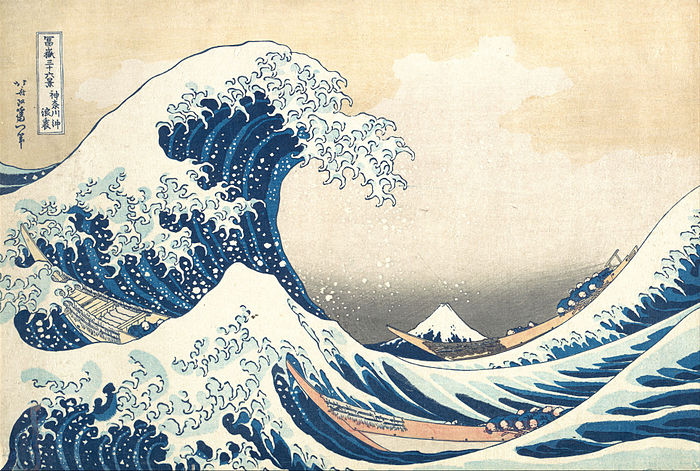In the daily office readings for this morning, we hear a reminder in Psalm 50 of the incredible power of God:
The mighty one, God the Lord,
speaks and summons the earth
from the rising of the sun to its setting.
Out of Zion, the perfection of beauty,
God shines forth.
Our God comes and does not keep silence,
before God is a devouring fire,
and a mighty tempest all around God.
The extolling of beauty’s perfection, and the reminder of our rightful awe at the power of God and God’s creation, calls to mind a particular work of art that is familiar to many.
In 1830, the Japanese artist Katsushika Hokusai published a series of engravings called Thirty-Six Views of Mount Fuji, widely considered to be his masterpiece. Outside Japan, the most famous image from that series is the woodblock engraving entitled The Great Wave Off Kanagawa.
The wave dominates the scene: it rises menacingly above three small boats and the souls therein, open like a panther’s paw to grasp at whatever comes into its path. It seems to move and even breathe with an energy all its own. It even dwarfs Mount Fuji, considered to be the epitome of beauty. The viewer is drawn into the scene by the artist’s decision to place the horizon below the crest of the wave, as if looking on from a boat of one’s own on the sea’s stormy surface. In fact, the wave is placed in such a way that it looks as if it has Mount Fuji in its grasp. At the time that Hokusai created this image, Japan was on the verge of emerging from centuries of isolationism, yet the artist himself was influenced by paintings of northern Europe, and his choice of Prussian blue, a color which was relatively new in painters’ palettes, as the dominant hue, offered the promise of change and a new path for Japan.
As in this morning’s psalm, humility before the power of creation is an idea that is profoundly expressed by Hokusai’s vision—and it is one that we particularly struggle with, believing as many of us do that creation has been placed into our hands to be disposed of as we wish. Yet the human power to destroy is nothing next to the power of creation. As we deal with rising sea levels and period of prolonged drought brought on by our failure to honor the fragile web of creation that both supports us and holds us dependent, we too can imagine a wave looming menacingly before us.
To me this painting is one that evokes the call to repentance that is at the heart of Lent, if we wish to avail ourselves the renewal that then can be ours. As we remember two years of pandemic, and now more than a week after the brutal attacks on civilians in the Russian invasion of Ukraine, we know that the waters beneath are troubled. But we can turn again. That’s the core of the treasures that Lent offers us. The steadfastness of God’s love for us calls us to turn, knowing that our hope rests in the embrace of the Almighty.
Too often we blithely row out into deep waters, forgetting that we have the ability to turn back when our path leads us toward potential disaster.
Lord, help us to remember how you uphold our lives by grace, and give us the wisdom to turn toward You again, that we may serve You and those around us in love and gratitude.
Leslie Scoopmire is a writer, musician, and a priest in the Diocese of Missouri. She is rector of St. Martin’s Episcopal Church in Ellisville, MO. She posts prayers, meditations, and sermons at her blog Abiding In Hope, and collects spiritual writings and images at Poems, Psalms, and Prayers.
Image: “The Great Wave off Kanagawa”, by Katsushika Hokusai, Public domain, via Wikimedia Commons via wikimedia commons (public domain)

